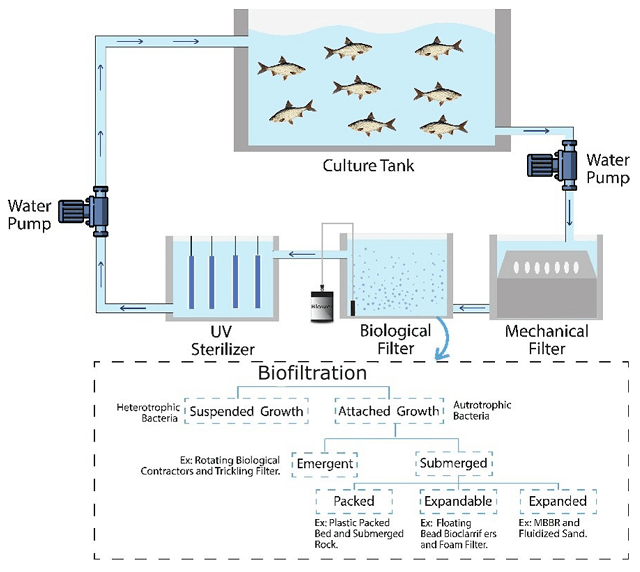Aeration becomes an essential aspect of biofilter performance to reduce ammonia nitrogen in Recirculating Aquaculture System (RAS) because it provides an aerobic environment in the biofilter for microbial degradation of organic matter and ammonia nitrogen.
Researchers from Padjadjaran University published a scientific review where they evaluated the key aspects responsible for ammonia nitrogen removal efficiencies, such as oxygen transfer, microbial community and biofilm thickness.
Types of biofilters in RAS
There are two well-known types of biofiltration based on the growth of microorganisms: attached growth (biofilm or fixed film) and suspended growth. The most used in recirculating aquaculture systems (RAS) is the one with attached growth because it is more stable.
In turn, the thin film is classified as an emergent filter or submerged filter.
The pop-up filter employs a cascade of water that directly flows over the biofilter media to maximize oxygen transfer.
In the submerged filter, the surfaces of the submerged biofilter media are used to support the growth of microbes, subsequently increasing the growth of biofilms.

Bubble aeration
Bubble aeration is critical to determine the efficiency of the biofilter in reducing ammoniacal nitrogen; and uses air or gas in the form of bubbles to provide dissolved oxygen to the biofilm growth medium.
Rising gas bubbles transfer oxygen to the liquid phase. Dissolved oxygen diffuses into the biofilm toward oxidative phosphorylation sites.
The efficiency of bubble aeration depends on the size of the bubbles: coarse or large bubble (diameter 2−5 mm), microbubble (diameter ≤50 µm), fine bubble (diameter 200−10 µm) and ultrafine bubble or nanobubble (diameter <200nm).

Effect of bubble size on biofilter performance
Recently, nanobubble aeration systems for RAS have gained a lot of interest due to their high mass transfer and long existence in an aqueous environment.
The study cites experience growing Nile tilapia in a RAS that used microbubble aeration to maintain the correct dissolved oxygen concentration. By maintaining an air flow of 10 L/min, the aerator guaranteed the necessary amount of dissolved oxygen concentration (4.61 mg/L).
Microbial community
The microbial community plays an important role in the growth and thickness of the biofilm. Conversely, biofilm thickness can also affect microbial activity and diversity due to limitation of diffusion and substrate penetration into the biofilm.
Likewise, the increase in the thickness of the biofilm can give rise to a more heterogeneous and biodiverse biofilm due to the stratification of metabolic processes and the greater concentration gradient.
However, excessive biofilm thickness will cause oxygen diffusion limitation, accumulate toxic metabolic byproducts, and result in less active biomass in the deeper biofilm due to low oxygen penetration.
Conclusion
The study reviews the advances on the bubble aeration system in biofilters for the treatment of wastewater in the RAS.
“Aeration bubble size affects the microbial community of nitrifying bacteria and consequently determines biofilm growth and thickness to improve ammonia removal efficiency,” they conclude.
They report that “the biofilter with an aeration system consisting of microbubbles and fine nanobubbles or a combination thereof achieved a removal efficiency of approximately >80% of TAN”.
“Based on the correlation between the microbial community and the thickness of the biofilm due to the different types of bubble aeration, it is concluded that the aeration system equipped with finer bubbles improves the proportion of nitrifying bacteria and, consequently, the growth and the thickness of the biofilm”, they conclude.
They emphasize that fine bubble and nanobubble aeration have very positive prospects for improving biofilter performance, although they are currently not widely used in recirculating aquaculture systems.
The study was funded by the Universitas Padjadjaran Academic Leadership Grant.
Reference (open access)
Suriasni, Putu Ayustin, Ferry Faizal, Camellia Panatarani, Wawan Hermawan, and I Made Joni. 2023. “A Review of Bubble Aeration in Biofilter to Reduce Total Ammonia Nitrogen of Recirculating Aquaculture System” Water 15, no. 4: 808. https://doi.org/10.3390/w15040808

